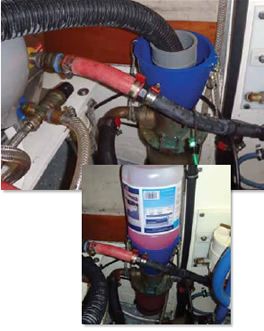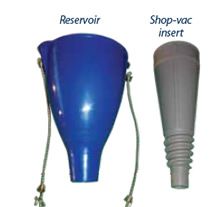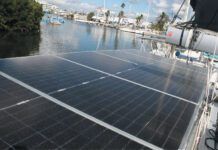
264
For those in colder climes, the only drag bigger than the end of the sailing season is the need to winterize engines, generators, and air-conditioning units in preparation for their long winter’s nap. Wandering the docks at the 2011 Annapolis Boat Show, we came across the Sea Flush, a new product designed to make the process relatively painless, eliminating the struggle to pull a cooling-system hose end or installing a “Y” valve in order to flush and winterize “raw water” cooling systems or the open side of a closed cooling system.
Virginia-based owner John Gregal developed the Sea Flush while working as a boat mechanic on the Potomac River. He realized his invention allowed him to winterize boats faster, using less antifreeze, and while working alone.
The Sea Flush is a two-piece, funnel-shaped device with an injection-molded plastic reservoir and a rubber shop-vac insert, which provides enough friction to hold the vacuum hose in place, freeing up the users hands to take care of other tasks. The reservoir fits into the top of any canister-style sea strainer with an inside opening of 1.6 inches to 5 inches, allowing users to winterize or do a freshwater flush through the sea strainer. The shop-vac insert screws into the reservoir, making it easier to use a shop vacuum to clear a clogged through-hull or purge water from a system as part of the winterizing process.

222
We decided to put the Sea Flush through its paces by using it to winterize the raw-water circuit on the freshwater-cooled Beta 43 engine on our Chesapeake-based test boat, a Union 36 (which we reviewed in the February 2010 issue). Testers found the Sea Flush easy to use and the instructions clear and easy to follow.
The first step was to remove the lid and filter basket from the engine sea strainer, then insert the Sea Flush reservoir into the body of the sea strainer and secure it in place with the two provided bungee cords. Because our test boat was in the water, the next step was to screw the shop-vac insert into the reservoir and use a shop vac to blow the seacock and hose clear of water. We used a 6-gallon, 5-horsepower vacuum, and it cleared the water with no problem. To keep water from re-entering the seacock and hose, we closed the seacock, then turned off the shop vac.
Next, testers removed the vacuum insert and upended a gallon of antifreeze into the reservoir, allowing the running engine to pull from it—much like an office-style water cooler. Prior to the reservoir emptying, we replaced the jug, which lasted until we saw a steady flow of antifreeze at the exhaust discharge, at which point, the engine was shut down, the reservoir removed, and the strainer basket and lid reinstalled.
The process for winterizing a generator would be the same, with a few minor variations for air-conditioning units.
Note that winterizing an engine without running it—by simply forcing antifreeze through the raw water loop with a shop vac—is a bad idea. Should the exhaust can fill up and drive the water-antifreeze mix into the exhaust manifold, an open exhaust valve will allow water to enter one or more cylinders, which could lead to rings rusted to the cylinder wall come spring time.
Bottom line
We liked the concept of the Sea Flush and found that it performed as advertised. In the past, we’ve used a bronze “T” fitting attached to the seacock, which allowed us to winterize by inserting a threaded hose barb connected to a length of hose run to a modified five-gallon bucket of antifreeze. This setup cost only $30—compared to the $69 Sea Flush—but it was a pain to use. The Sea Flush was faster and easier, and it allowed us to more accurately monitor the amount of antifreeze needed. Even with a lifetime warranty against defects, the Sea Flush seems pricey, but for those with multiple systems (engine, generator, AC unit, etc.) to winterize, it’s a good deal. It’s use for unclogging through-hulls and freshwater rinsing are bonuses.


































